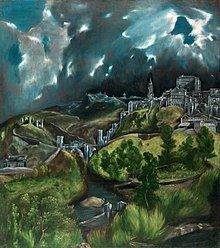El Greco was an artist of Greek origin who spent most of his life in Spain. His real name was Kyriakos (Domenikos) Theotokopoulos. He is known by his Spanish name, which means simply "the Greek." El Greco is recognized as one of the great geniuses of Western art. He is most famous for his religious paintings, but he also painted portraits of his patrons and friends.
El Greco was born on the island of Crete, off the coast of Greece. Little is known about his childhood, but he apparently studied painting from an early age. As a young man, he went to the city of Venice to learn about Italian art. He studied the work of such masters as Titian and Tintoretto.
By 1570, El Greco had moved to Rome for additional training. Once settled there, he joined a circle of artists and scholars. But in spite of these connections, he never managed to obtain an important commission. For this reason, he left Rome for Spain in 1577, probably to help with the decoration of a family chapel in Toledo.
Toledo was then a prosperous manufacturing city and the center of the Catholic Church in Spain. It was in this city that El Greco produced his greatest masterpieces. He found the patrons he could not find in Rome. Within a few years, he had set up a workshop that produced numerous altarpieces and other paintings for Toledo's churches and monasteries. He also sold paintings in other cities.
Surprisingly, El Greco never managed to obtain the patronage of the Spanish king, who ruled from Madrid. He remained in Toledo, his adopted home, until his death in 1614.
El Greco's artistic style contains traces of his native Greece. But he was influenced mainly by the Italian mannerist school. Members of this school believed that artists had the right to interpret nature in their individual styles. Such ideas led El Greco to lengthen and distort most of his figures. He believed that they were more spiritual and more expressive than ordinary figures. He tried other techniques to express emotion and portray passion in his work. He used bright, vivid colors and painted his subjects in a special, almost heavenly, light.
El Greco was successful in Toledo, but his art was not fully appreciated until long after his death. He was called a madman and a mystic. Some critics falsely believed that poor eyesight caused him to distort the figures in his paintings. The myths and mysteries surrounding him began to disappear when Manuel Cossío, an important critic, published a biography of El Greco in 1908. Since then, El Greco has taken his rightful place among the world's greatest painters.
The Adoration of the Shepherds, which celebrates the birth of the Christ Child, is one of El Greco's well-known religious paintings.
 | |
| View of Toledo | ( Metropolitan Museum of Art, New York) is one of the two surviving landscapes of Toledo painted by El Greco |
 |
| " El Entierrro del Conde Orgaz" |


Estoy anonadadoo con sus pinturas especialmente es preciosa El Entierro de;l Conde Orgaz, Nomas pinro una del Conde?
ResponderEliminar